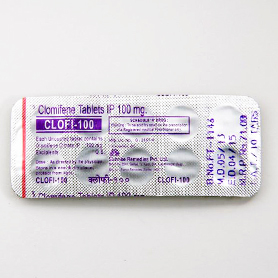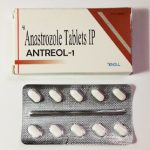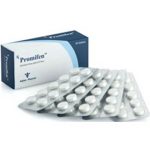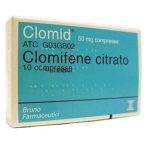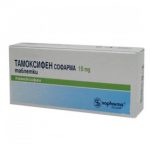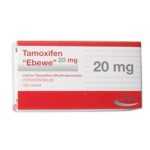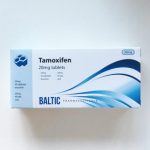Clomid 100mg Info
What is clomiphene?
Clomiphene is a non-steroidal fertility medicine. It causes the pituitary gland to release hormones needed to stimulate ovulation (the release of an egg from the ovary).
Clomiphene is used to cause ovulation in women with certain medical conditions (such as polycystic ovary syndrome) that prevent naturally occurring ovulation.
Clomiphene may also be used for purposes not listed in this medication guide.
Important information
Do not use clomiphene if you are already pregnant.
You should not use clomiphene if you have: liver disease, abnormal vaginal bleeding, an uncontrolled adrenal gland or thyroid disorder, an ovarian cyst (unrelated to polycystic ovary syndrome), or if you are pregnant.
Advertisement
SLIDESHOW
Multiple Sclerosis: What’s New in Treatment Options?
Before taking this medicine
You should not use clomiphene if you are allergic to it, or if you have:
- abnormal vaginal bleeding;
- an ovarian cyst that is not related to polycystic ovary syndrome;
- past or present liver disease;
- a tumor of your pituitary gland;
- an untreated or uncontrolled problem with your thyroid or adrenal gland; or
- if you are pregnant.
- To make sure clomiphene is safe for you, tell your doctor if you have:
endometriosis or uterine fibroids.
Do not use clomiphene if you are already pregnant. Talk to your doctor if you have concerns about the possible effects of this medicine on a new pregnancy.
Clomiphene can pass into breast milk and may harm a nursing baby. This medication may slow breast milk production in some women. Tell your doctor if you are breast-feeding a baby.
Using clomiphene for longer than 3 treatment cycles may increase your risk of developing an ovarian tumor. Ask your doctor about your specific risk.
Fertility treatment may increase your chance of having multiple births (twins, triplets). These are high-risk pregnancies both for the mother and the babies. Talk to your doctor if you have concerns about this risk.
How should I take clomiphene?
Use clomiphene exactly as directed by your doctor. Follow all directions on your prescription label. Your doctor may occasionally change your dose to make sure you get the best results. Do not take this medicine in larger or smaller amounts or for longer than recommended.
Your doctor will perform medical tests to make sure you do not have conditions that would prevent you from safely using clomiphene.
Clomiphene is usually taken for 5 days, starting on the 5th day of your menstrual period. Follow your doctor’s instructions.
You will need to have a pelvic examination before each treatment cycle. You must remain under the care of a doctor while you are using this medicine.
You will most likely ovulate within 5 to 10 days after you take clomiphene. To improve your chance of becoming pregnant, you should have sexual intercourse while you are ovulating.
Your doctor may have you take your temperature each morning and record your daily readings on a chart. This will help you determine when you can expect ovulation to occur.
In most cases, clomiphene should not be used for more than 3 treatment cycles.
If ovulation occurs but you do not get pregnant after 3 treatment cycles, your doctor may stop treatment and evaluate your infertility further.
Store at room temperature away from moisture, heat, and light.
What happens if I miss a dose?
Call your doctor for instructions if you miss a dose of clomiphene.
What happens if I overdose?
Seek emergency medical attention or call the Poison Help line at 1-800-222-1222.
What should I avoid?
This medication may cause blurred vision. Be careful if you drive or do anything that requires you to be alert and able to see clearly.
Clomiphene side effects
Get emergency medical help if you have any signs of an allergic reaction to clomiphene: hives; difficult breathing; swelling of your face, lips, tongue, or throat.
Some women using this medicine develop a condition called ovarian hyperstimulation syndrome (OHSS), especially after the first treatment. OHSS can be a life threatening condition. Call your doctor right away if you have any of the following symptoms of OHSS:
- stomach pain, bloating;
- nausea, vomiting, diarrhea;
- rapid weight gain, especially in your face and midsection;
- little or no urinating; or
- pain when you breathe, rapid heart rate, feeling short of breath (especially when lying down).
- Stop using clomiphene and call your doctor at once if you have:
- pelvic pain or pressure, enlargement in your pelvic area;
- vision problems;
- seeing flashes of light or floaters in your vision;
- increased sensitivity of your eyes to light; or
- heavy vaginal bleeding.
- Common clomiphene side effects may include:
- flushing (warmth, redness, or tingly feeling);
- breast pain or tenderness;
- headache; or
breakthrough bleeding or spotting.
This is not a complete list of side effects and others may occur. Call your doctor for medical advice about side effects. You may report side effects to FDA at 1-800-FDA-1088.
See also: Side effects (in more detail)
Clomiphene dosing information
Usual Adult Dose for Ovulation Induction:
50 mg orally once a day for 5 days. Therapy should be initiated on or near the 5th day of the menstrual cycle, but may be started at any time in patients without recent uterine bleeding.
If ovulation occurs and pregnancy is not achieved, up to 2 additional courses of clomiphene 50 mg orally once a day for 5 days may be administered. Each subsequent course may be started as early as 30 days after the previous course and after pregnancy has been excluded.
Most patients ovulate following the first course of therapy. However, if the patient fails to ovulate, a second course of 100 mg/day for 5 days may be given as early as 30 days following the initial course. A third course of 100 mg/day for 5 days may be given after 30 days, if necessary.
Treatments beyond three cycles of clomiphene, dosages greater than 100 mg once a day, and/or course durations beyond 5 days are not recommended by the manufacturer. However, successful pregnancies and term deliveries have been reported in women receiving up to 200 mg/day for 5 days, or extended 10-day course of therapy, or consecutive cycles of treatment beyond the 3 recommended by the manufacturer.
Usual Adult Dose for Lactation Suppression:
- 50 to 100 mg orally once a day for 5 days. Generally, one course of therapy is sufficient.
- Usual Adult Dose for Oligospermia:
- 25 to 100 mg orally once a day. Therapy is generally given over a period of several months.
What other drugs will affect clomiphene?
Other drugs may interact with clomiphene, including prescription and over-the-counter medicines, vitamins, and herbal products. Tell each of your health care providers about all medicines you use now and any medicine you start or stop using.
For the Consumer
Applies to clomiphene: oral tablet
In addition to its needed effects, some unwanted effects may be caused by clomiphene. In the event that any of these side effects do occur, they may require medical attention.
You should check with your doctor immediately if any of these side effects occur when taking clomiphene:
- More common
- Bloating
stomach or pelvic pain
If any of the following side effects occur while taking clomiphene, check with your doctor or nurse as soon as possible:
- Less common or rare
- Blurred vision
- decreased or double vision or other vision problems
- seeing flashes of light
- sensitivity of eyes to light
yellow eyes or skin
Some of the side effects that can occur with clomiphene may not need medical attention. As your body adjusts to the medicine during treatment these side effects may go away. Your health care professional may also be able to tell you about ways to reduce or prevent some of these side effects. If any of the following side effects continue, are bothersome or if you have any questions about them, check with your health care professional:
- More common
- Hot flashes
- Less common or rare
- Breast discomfort
- dizziness or lightheadedness
- headache
- heavy menstrual periods or bleeding between periods
- mental depression
- nausea or vomiting
- nervousness
- restlessness
- tiredness
- trouble in sleeping
- For Healthcare Professionals
- Applies to clomiphene: compounding powder, oral tablet
General
At recommended dosages, clomiphene is generally well tolerated. Adverse reactions usually are mild, transient, and resolve when clomiphene is discontinued.
Genitourinary
Male sterility after high dose therapy may be due to hyalinization of the tubular membranes and damage to the spermatids. In general, clomiphene enhances spermatozoal motility and does not change the sperm to abnormal or immature forms.
Very common (10% or more): Ovarian enlargement, ovarian hyperstimulation syndrome
Common (1% to 10%): Abnormal uterine bleeding (intermenstrual spotting, menorrhagia), multiple pregnancies, spontaneous abortions (ectopic pregnancies, hydatiform moles, fetus papyraceous)
Uncommon (0.1% to 1%): Stillbirths, increased urinary frequency/volume, vaginal dryness, priapism
Frequency not reported: Temporary sterility in males
Postmarketing reports: Endometriosis, ovarian cyst, ovarian hemorrhage, tubal pregnancy, uterine hemorrhage
Ocular
Common (1% to 10%): Blurred vision, lights, floaters, waves, unspecified visual complaints, photophobia, diplopia, scotomata, phosphenes
Frequency not reported: Scintillations, heat waves, irreversible palinopsia (prolonged afterimages), shimmering of the peripheral field
Postmarketing reports: Abnormal accommodation, cataract, eye pain, macular edema, optic neuritis, photopsia, posterior vitreous detachment, retinal hemorrhage, retinal thrombosis, retinal vascular spasm, temporary or prolonged loss of vision, possibly irreversible
Cardiovascular
Very common (10% or more): Vasomotor flushes
Postmarketing reports: Arrhythmias, chest pain, edema, hypertension, palpitations, phlebitis, pulmonary embolism, shortness of breath, tachycardia, thrombophlebitis.
Endocrine
Frequency not reported: Gynecomastia, thyroid disorders
Postmarketing reports: Thyroid disorders
Oncologic
Uncommon (0.1% to 1%): Leydig cell tumor of testis (in male treated for oligospermia)
Frequency not reported: Ovarian cancer, increased risk of borderline or invasive ovarian tumor
Postmarketing reports: Hepatic hemangiosarcoma, liver cell adenoma, hepatocellular carcinoma, fibrocystic disease, breast carcinoma, endometrial carcinoma, astrocytoma, pituitary tumor, prolactinoma, neurofibromatosis, glioblastoma multiforme, brain abscess, luteoma of pregnancy, dermoid cyst of the ovary, ovarian carcinoma, hydatiform mole, choriocarcinoma, melanoma, myeloma, perianal cysts, renal cell carcinoma, Hodgkin’s lymphoma, tongue carcinoma, bladder carcinoma
Nervous system
Common (1% to 10%): Headache
Uncommon (0.1% to 1%): Dizziness, insomnia, light-headedness, nervous tension, vertigo
Postmarketing reports: Migraine headache, paresthesia, seizure, stroke, syncope
Dermatologic
Uncommon (0.1% to 1%): Dermatitis, rash, hair loss, dry hair
Frequency not reported: Reversible alopecia, urticaria, acne, erythema nodosum, erythema multiforme
Postmarketing reports: Acne, allergic reaction, erythema, erythema multiforme, erythema nodosum, hypertrichosis, pruritis, urticaria
Gastrointestinal
Common (1% to 10%): Abdominal-pelvic discomfort/distention/bloating, nausea, vomiting
Uncommon (0.1% to 1%): Acute abdomen, constipation, diarrhea
Hematologic
Uncommon (0.1% to 1%): Deep vein thrombosis
Frequency not reported: Pituitary hemorrhage (with undiagnosed pituitary tumor)
Postmarketing reports: Leukocytosis
A 32-year-old woman receiving clomiphene citrate treatment for ovulation induction was admitted for complaints of swelling and pain in her right calf. Her medical history was unremarkable except for complications following an appendectomy three years prior which resulted in a deep vein thrombosis (DVT) and subsequent pulmonary embolism. The patient had been taking clomiphene two days prior to the development of the first DVT. Six months later, the treatment with clomiphene was renewed. The patient developed recurrent DVT following repeated standard clomiphene treatment.
Hepatic
Postmarketing reports: Increased transaminases, hepatitis
Metabolic
Uncommon (0.1% to 1%): Increased appetite, weight gain/loss
Musculoskeletal
Postmarketing reports: Arthralgia, back pain, myalgia
Other
Common (1% to 10%): Breast discomfort
Uncommon (0.1% to 1%): Fatigue
Frequency not reported: Elevated levels of desmosterol (for prolonged therapy)
Postmarketing reports: Fever, tinnitus, weakness
Fetal/Neonatal Anomalies and Mortality:
Uncommon (0.1% to 1%): Congenital heart lesions, down syndrome, club foot, congenital gut lesions, hypospadias, microcephaly, harelip and cleft palate, congenital hip, hemangioma, undescended testicles, polydactyly, conjoined twins and teratomatous malformation, patent ductus arteriosus, amaurosis, arteriovenous fistula, inguinal hernia, umbilical hernia, syndactyly, pectus excavatum, myopathy, dermoid cyst of scalp, omphalocele, spina bifida occulta, ichthyosis, and persistent lingual frenulum, neonatal death, fetal death/stillbirth
Postmarketing reports: Skeletal malformations of the skull, face, nasal passages, jaw, hand, limb (ectromelia including amelia, hemimelia, and phocomelia), foot (clubfoot), spine, joints; septal heart defects, muscular ventricular septal defect, patent ductus arteriosus, tetralogy of Fallot, coarctation of the aorta; down syndrome; ear abnormalities and deafness; cleft lip and palate, imperforate anus, tracheoesophageal fistula, diaphragmatic hernia, omphalocele; hypospadias, cloacal exstrophy, lung tissue malformations; malformations of the eye and lens (cataract); neuroectodermal tumor, thyroid tumor, hepatoblastoma, lymphocytic leukemia; neural tube defects (anencephaly, meningomyelocele), microcephaly, hydrocephalus; renal agenesis and renal dysgenesis; dwarfism, mental retardation
Applies to the following strength(s): 50 mg
Usual Adult Dose for:
- Ovulation Induction
- Lactation Suppression
- Oligospermia
- Additional dosage information:
- Renal Dose Adjustments
- Liver Dose Adjustments
- Dialysis
Usual Adult Dose for Ovulation Induction
50 mg orally once a day for 5 days. Therapy should be initiated on or near the 5th day of the menstrual cycle, but may be started at any time in patients without recent uterine bleeding.
If ovulation occurs and pregnancy is not achieved, up to 2 additional courses of clomiphene 50 mg orally once a day for 5 days may be administered. Each subsequent course may be started as early as 30 days after the previous course and after pregnancy has been excluded.
Most patients ovulate following the first course of therapy. However, if the patient fails to ovulate, a second course of 100 mg/day for 5 days may be given as early as 30 days following the initial course. A third course of 100 mg/day for 5 days may be given after 30 days, if necessary.
Treatments beyond three cycles of clomiphene, dosages greater than 100 mg once a day, and/or course durations beyond 5 days are not recommended by the manufacturer. However, successful pregnancies and term deliveries have been reported in women receiving up to 200 mg/day for 5 days, or extended 10-day course of therapy, or consecutive cycles of treatment beyond the 3 recommended by the manufacturer.
Usual Adult Dose for Lactation Suppression
50 to 100 mg orally once a day for 5 days. Generally, one course of therapy is sufficient.
Usual Adult Dose for Oligospermia
25 to 100 mg orally once a day. Therapy is generally given over a period of several months.
Renal Dose Adjustments
Dosage reductions are not recommended for patients with renal dysfunction during short term clomiphene therapy. Dosage reductions are also not recommended for patients with renal dysfunction during long term clomiphene therapy. However, the half-life of clomiphene may be prolonged with chronic therapy and patients with renal dysfunction should be monitored for patient response and tolerance.
Liver Dose Adjustments
Clomiphene is contraindicated in patients with liver disease or a history of liver dysfunction.

